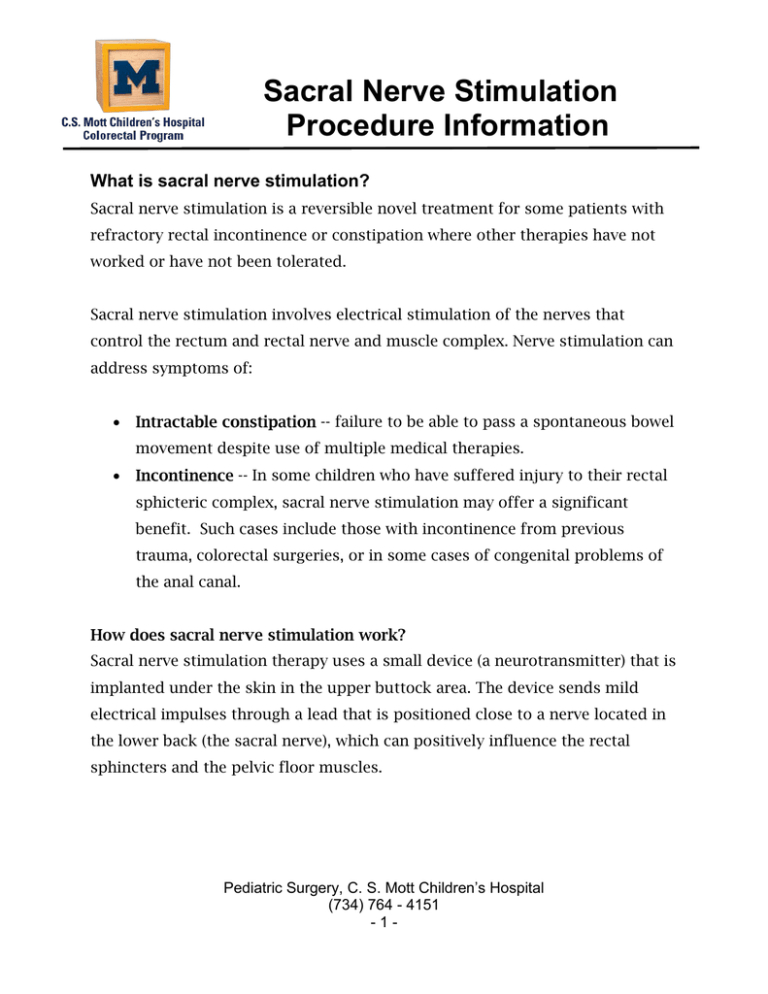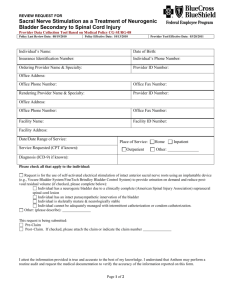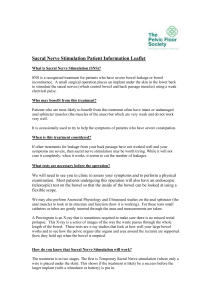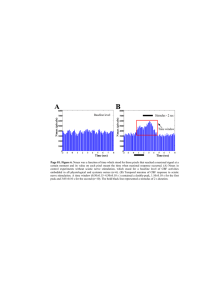Sacral Nerve Stimulation Procedure Information
advertisement

Sacral Nerve Stimulation Procedure Information What is sacral nerve stimulation? Sacral nerve stimulation is a reversible novel treatment for some patients with refractory rectal incontinence or constipation where other therapies have not worked or have not been tolerated. Sacral nerve stimulation involves electrical stimulation of the nerves that control the rectum and rectal nerve and muscle complex. Nerve stimulation can address symptoms of: -- failure to be able to pass a spontaneous bowel movement despite use of multiple medical therapies. -- In some children who have suffered injury to their rectal sphicteric complex, sacral nerve stimulation may offer a significant benefit. Such cases include those with incontinence from previous trauma, colorectal surgeries, or in some cases of congenital problems of the anal canal. Sacral nerve stimulation therapy uses a small device (a neurotransmitter) that is implanted under the skin in the upper buttock area. The device sends mild electrical impulses through a lead that is positioned close to a nerve located in the lower back (the sacral nerve), which can positively influence the rectal sphincters and the pelvic floor muscles. Pediatric Surgery, C. S. Mott Children’s Hospital (734) 764 - 4151 -1- Children will undergo a two stage placement. Both of these are done under a general anesthesia, and performed by a specially trained team of surgeons. Each of these are outpatient procedures, and your child is then followed by our group to maximize the benefits of the device. The first is a temporary procedure and is used as a test to see if the sacral nerve stimulator improves your child bowel function. The electrical lead is placed into the third sacral nerve root. The device is placed under the skin, but a wire will hang from the child, along with a 1 1/2 inch electrical unit which communicates with a pacer device that our Medtronic technician will help optimize. This test phase will take from 2 to 4 weeks. During this time you will carefully keep track of how your child stools and we will compared it to your records from before the surgery If we feel that the test phase is successful, we will proceed with the formal implantation of the sacral nerve stimulator. This is a one hour procedure, and is generally done on an outpatient bases. Pediatric Surgery, C. S. Mott Children’s Hospital Sacral Nerve Stimulation Procedure Information -2- What should I expect after the procedure? The incision area will feel sore and/or painful for a couple of weeks. This will lessen as your child heals. You will receive a full set of instructions on activity and wound care after each phase of the procedure. If the Phase I trial is not successful, we will plan to remove the device, again under a general anesthetic and this will only take about 20 minutes. Will the device ever need to be replaced? Yes. The battery inside the neurostimulator typically needs to be replaced every 3 to 5 years. The battery life will fluctuate per individual, depending on strength of the signal needed to control symptoms and amount of use each day. When it is time for the battery to be replaced, the entire neurostimulator will be replaced with a new one. Yes. You cannot have a MRI while the device is implanted -- even if the device’s battery is turned off. According to the device manufacturer, x-ray and radiation therapy may affect the function of the device. Diathermy (a type of energy treatment -- using radio wave, ultrasound, or microwave) should not be done on any patient with a sacral nerve stimulator implant. Consult with your doctor before scheduling any additional therapies or tests. He or she will discuss the need to take any precautions. Important Note While this device has been implanted in several children, the Food and Drug Administration has not approved implantation into children 15 and younger. Pediatric Surgery, C. S. Mott Children’s Hospital Sacral Nerve Stimulation Procedure Information -3- Thus, we will need to determine the safety and benefit of such an implantation into younger children on a case by case basis. As well, we will have to obtain permission from your insurance provider before such an implantation. Who do I can for questions? If you have any question, problems or concerns call the Pediatric Surgery clinic from 8-5:00pm Monday thru Friday, 734-764-4151. After 5:00pm or on the weekends if you have urgent issues call hospital paging at 734 936-4000 and ask the operator to page the Pediatric Surgeon “on call”. Disclaimer: This document contains information and/or instructional materials developed by the University of Michigan Health System (UMHS) for the typical patient with your condition. It may include links to online content that was not created by UMHS and for which UMHS does not assume responsibility. It does not replace medical advice from your health care provider because your experience may differ from that of the typical patient. Talk to your health care provider if you have any questions about this document, your condition or your treatment plan. Author: Erin Larowe Reviewer: Daniel Teitelbaum, MD Patient Education by University of Michigan Health System is licensed under a Creative Commons Attribution-NonCommercial-ShareAlike 3.0 Unported License. Last Revised 12/2014 Pediatric Surgery, C. S. Mott Children’s Hospital Sacral Nerve Stimulation Procedure Information -4-



